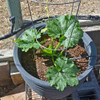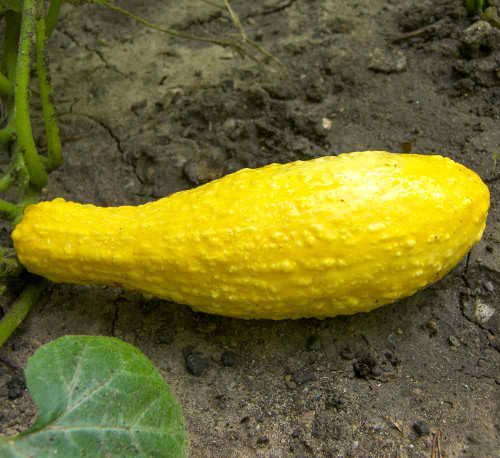Description
Golden Zucchini Summer Squash - The Color of Sunshine
There's a special kind of cheer and practicality that Golden Zucchini brings to the summer garden and kitchen. That vibrant golden-yellow makes the fruit remarkably easy to spot amidst the green foliage, ensuring you catch it at its peak. Beyond its sunny color, many gardeners find its flavor a touch sweeter and more delicate than some green varieties, complemented by a wonderfully tender, thin skin that rarely needs peeling. When you combine these culinary qualities with its practical, space-saving bush habit and the fascinating story of its 20th-century color innovation, Golden Zucchini truly earns its place in your garden.
Details
Celebrated for its striking golden-yellow fruit that brightens both garden and plate, Golden Zucchini is a vibrant summer squash offering mild flavor and versatile kitchen uses. It typically grows as a compact, bush-type plant, a practical advantage for home gardens with limited space, raised beds, or large containers. Mature plant size generally ranges from 1.5 to 4 feet in height and spread. The large, characteristic squash leaves are lobed and can have tiny, prickly hairs. Leaves can exceed 6 inches in both length and width. The foliage color can range from medium green to yellow-green. It is also common for leaves to exhibit natural light greenish-gray splotches or streaks on their surface; these markings are a natural feature and should not be mistaken for signs of disease.
Each plant bears separate male and female large, golden-yellow, star-shaped flowers. Male flowers appear on slender stalks, while female flowers are easily identified by the miniature zucchini at their base. These large, showy blossoms are edible and require pollination by bees or other insects for fruit to set. This type matures quickly, with harvests often beginning 45 to 65 days from sowing. It is grown as a warm-season annual across USDA Zones 3-11. Golden Zucchini plants are highly sensitive to frost and light freezes.
The fruit is generally cylindrical and slender. For the best flavor and texture – hallmarks of this variety – the ideal fruit will be 6-8 inches long and about 1.5-2 inches in diameter, with vibrant golden-yellow, smooth, and glossy skin. Inside, the flesh is creamy white, firm, and tender. Its eating quality is exceptional: the skin is famously thin and requires no peeling, simplifying kitchen preparation. The flavor of Golden Zucchini is consistently described as mild, delicate, and slightly sweet, "buttery" or "snappy". When compared directly to green zucchini, Golden Zucchini is often described as being sweeter.
History
The species Cucurbita pepo is native to the Americas, where it has been cultivated for millennia. Archaeological evidence points to its domestication thousands of years before European contact. The oldest known sites of C. pepo cultivation are in southern Mexico, specifically in Oaxaca, with remains dating back 8,000–10,000 years, and in Ocampo, Tamaulipas, around 7,000 years ago.
From these ancient American origins, the specific cylindrical summer squash form we know as zucchini developed much later in Italy, around the mid-to-late 19th century. The distinct "Golden Zucchini" type is a 20th-century horticultural achievement, with its widespread commercial introduction largely credited to the W. Atlee Burpee Company in 1973, stemming from the work of Dr. Oved Shifrin with the "B" gene responsible for the golden color. This open-pollinated type (and its subsequent cultivars) allows gardeners to connect with a more recent chapter of breeding innovation, distinct from ancient landraces but firmly an heirloom in its own right.
Uses
Golden Zucchini is prized for its adaptability in the kitchen and mild, delicate, slightly sweet flavor that readily absorbs seasonings. Its tender, firm, creamy flesh and thin skin (no peeling needed!) make it ideal for numerous preparations, simplifying kitchen work considerably. Enjoy it raw, sliced thinly for salads, used as a fresh appetizer like vegetarian carpaccio, or served with dips.
It shines when cooked via grilling, steaming, sautéing, roasting, or baking into savory breads, casseroles, and gratins. Grated zucchini adds moisture and hidden nutrition to muffin or bread batter and can be used for vegetable pancakes or fritters. When sliced thinly lengthwise, it makes an excellent substitute for conventional noodles in pasta dishes. Larger, more mature squashes (though less tender) are perfectly sized for hollowing out and baking when stuffed with meats, cheeses, and grains. Don't forget the large, golden male blossoms – they are also edible and delicious when stuffed with soft cheeses and herbs then battered and fried. Harvested zucchini also freezes well after blanching for later use.
The flavor and texture of Golden Zucchini complement a wide variety of ingredients. It pairs well with tomatoes, garlic, corn, eggplant, fresh herbs such as parsley, basil, oregano, thyme, and rosemary, olive oil, pine nuts, eggs, citrus juice, sausage, roasted chicken, and cheeses such as ricotta, mozzarella, parmesan, feta, or cotija. Whole, unwashed zucchini keep up to one week wrapped in the refrigerator crisper.
Companion Planting
Like other summer squash, Golden Zucchini benefits from companions that attract pollinators (bees are crucial for its fruit set). Planting borage, marigolds, or nasturtiums nearby can increase pollinator visits and potentially draw beneficial predatory insects. Legumes like bush beans or peas can help enrich the soil with nitrogen, benefiting these heavy feeders.
Avoid planting near potatoes. Good crop rotation (3-4 years) away from other cucurbits (melons, cucumbers, other squash) is recommended.
Planting and Growing Tips
Golden Zucchini thrives in warm weather and requires full sun (6-8+ hours daily). Plant only after all danger of frost has passed and soil has warmed to at least 65°F (70-95°F is optimal for germination). It demands rich, fertile, well-drained soil, so amend generously with compost or aged manure. Direct sowing seeds ½ to 1 inch deep is often preferred. Plant in rows or hills, thinning to the strongest plants spaced 18-36 inches apart to ensure good air circulation. Consistent moisture is crucial (about 1-1.5 inches per week), especially during flowering and fruit development, to prevent stress that can lead to bitterness or blossom end rot. Water deeply at the soil level to keep foliage dry. Golden Zucchini are heavy feeders; supplement initial soil amendments with side-dressings of balanced fertilizer or compost tea once plants begin to set fruit. Mulch heavily to conserve moisture, suppress weeds, and keep fruit clean. Pollination: If fruit set is poor despite good flowering, hand-pollination may be necessary, especially if bee activity is low.
Harvesting Tips
Harvest Golden Zucchini frequently (daily or every other day during peak season) for the best quality and to encourage continued production. Pick fruits when they are young and tender, typically 6-8 inches long (some prefer even smaller for exceptional tenderness). The skin should be smooth, glossy, and a vibrant golden-yellow. Oversized fruits become seedy, tough, and less flavorful. Use a sharp knife or pruners to cut the stem from the plant, leaving about an inch attached to the zucchini. Harvest in the cool of the morning if possible. Edible flowers are best picked midday when fully open.
Learn More
From the soil to the seed to the food you eat - we'll help you grow your best garden!



















